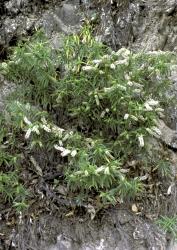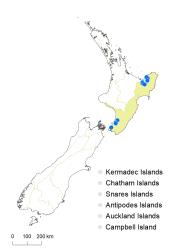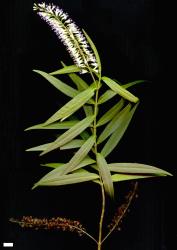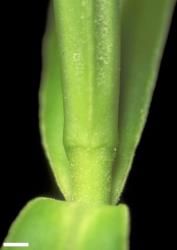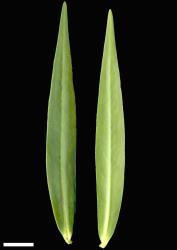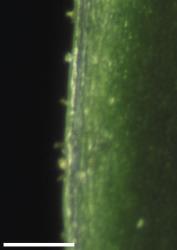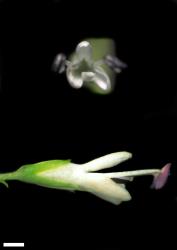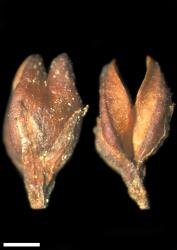- ≡ Veronica salicifolia var. angustissima Cockayne, Trans. & Proc. New Zealand Inst. 50: 184 (1918)
- ≡ Hebe angustissima (Cockayne) Bayly & Kellow, Illustr. Guide New Zealand Hebes 305 (2006)
Openly branched, bushy shrub to 1.4 m tall. Stems ascending to erect; eglandular-pubescent; hairs bifarious or uniform. Leaf bud distinct, its leaves appressed at margins until fully grown; sinus absent. Leaves opposite-decussate, spreading to recurved; lamina thin, linear to linear-lanceolate, 22–75 mm long, 3–9 mm wide, dull, dark green above, pale green beneath; midrib evident; surfaces often eglandular-hairy along midrib, sometimes minutely glandular-hairy, or glabrous; margin eglandular- and glandular-ciliolate, entire; apex mostly acute or sometimes sub-acute; base cuneate; petiole indistinct, winged, 1–2 mm long. Inflorescence a lateral raceme, 47–110 mm long; flowers crowded, 29–95, all bisexual; bracts alternate or loosely whorled, narrowly oblong to oblanceolate, ≤ pedicels; pedicels spreading to recurved, 1.8–3.5 mm long, puberulent all around. Calyx lobes 4, mostly acute or sometimes obtuse, 2.0–2.5 mm long, equal or sub-equal, mixed glandular- and eglandular-ciliate, sometimes also eglandular-hairy or minutely glandular-hairy on outside of lobes. Corolla 2–4 mm diameter; tube white, 2.2–4.0 mm long, > calyx, hairy inside; lobes 4, white or pale purplish, sub-erect to erecto-patent, sub-equal, lanceolate to elliptic or oblong, 2.0–3.2 mm long, sub-acute to obtuse; nectar guides absent. Stamen filaments white, 4.0–4.5 mm long; anthers purplish to magenta. Style glabrous, 3.5–6.0 mm long. Capsules latiseptate, sub-acute to obtuse, glabrous, 2.2–3.0 mm long, 1.4–2.6 mm at widest point. Seeds discoid to ellipsoid, flattened, smooth, straw-yellow to brown, 0.8–1.0 mm long.
V. angustissima is very similar to V. stricta and its recognition as a distinct species based only on its narrower leaves would be problematic except for its different flavonoid profile (Bayly & Kellow 2006, Mitchell et al. 2007). V. stricta plants usually have broader leaves (5–45 mm wide). However, narrow leaves that overlap with the range seen in V. angustissima can be found in all varieties of V. stricta. Some in the tetraploid V. stricta var. egmontiana, which does not overlap in geographic range with V. angustissima, may be narrower than those seen in V. angustissima. North of the Manawatu Gorge, V. stricta plants generally have calyx lobes that are hairy on their outer surfaces, whereas such hairs occur only rarely in V. angustissima. However, some samples collected together with V. angustissima were assigned to V. stricta because of their broader leaves, but they have glabrous surfaces on the calyx lobes (e.g., Bayly 1205, WELT SP081603). V. stricta populations are usually gynodioecious, including some female plants, which are distinguished by having generally smaller and paler anthers that are empty of pollen.
V. tairawhiti is also similar and grows in the Gisborne region, close to the locations of V. angustissima in eastern Bay of Plenty, but the ranges of the two do not overlap. V. tairawhiti plants also have narrow leaves, but these are broadest at the very base and thicker. V. tairawhiti plants are usually larger and have more flowers per inflorescence.
North Island: Gisborne (Mōtū and Waioeka Valleys); Southern North Island (Ōtaki River and tributaries and a single collection from Takapu Valley, near Wellington). Also, a specimen from Whakataki, near Castlepoint [Oliver, WELT], identified as V. stricta, closely resembles V. angustissima plants, but it is not mapped here).
Rocky sites in river gorges, often within the flood zone. Recorded elevations range from 30 to 244 m.
Flowers: February–April, rarely extending to June; fruits: March–July, persisting to January.
2n = 40 (see Bayly & Kellow 2006, as Hebe angustissima).
Veronica angustissima is classified in V. subg. Pseudoveronica sect. Hebe and the informal group “Occlusae” (Albach & Meudt 2010; Bayly & Kellow 2006).
The flowers are slender and delicate and don’t open widely. The calyx lobes have broad white or pinkish margins.
The Māori names koromiko, kōkōmuka, and variants – applied to V. stricta and V. salicifolia – might also be applied to similar large-leaved hebes, such as V. angustissima.



